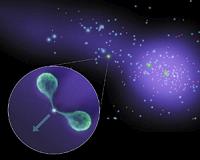 |
London, UK (SPX) Nov 25, 2010 An international team of astronomers have discovered a unique and exotic star system with a very cool methane-rich (or T-) dwarf star and a 'dying' white dwarf stellar remnant in orbit around each other. The system is a 'Rosetta Stone' for T-dwarf stars, giving scientists the first good handle on their mass and age. The team, led by Dr. Avril Day-Jones of the Universidad de Chile and including Dr. David Pinfield of the University of Hertfordshire as well as astronomers from the University of Montreal, publish their results in the journal Monthly Notices of the Royal Astronomical Society. The system is the first of its type to be found. The two stars are low in mass and have a weak mutual gravitational attraction as they are separated by about a quarter of a light-year or 2.5 trillion km (to put this in context Neptune is only 4.5 billion km from the Sun). Despite the frailty of the system it has stayed together for billions of years, but its stars are cooling down to a dark demise. Methane dwarfs are on the star/planet boundary and are about the size of the giant planet Jupiter. They have temperatures of less than 1000 degrees Celsius (in comparison the Sun's surface is at 5500 degrees Celsius). Methane is a fragile molecule destroyed at warmer temperatures, so is only seen in very cool stars and objects like Jupiter. Neither giant planets nor T-dwarf stars are hot enough for the hydrogen fusion that powers the Sun to take place, meaning that they simply cool and fade over time. White dwarfs are the end state of stars similar to and including the Sun. Once such stars have exhausted the available nuclear fuel in their cores, they expel most of their outer layers into space forming a remnant planetary nebula and leaving behind a hot, but cooling core or white dwarf about the size of the Earth. For our Sun this process will begin about 5 billion years in the future. In the newly-discovered binary, the remnant nebula has long since dissipated and all that is left is the cooling white dwarf and methane dwarf pair. Dr. Day-Jones puts this in context, commenting, "In about 6 billion years' time, when our Sun 'dies' and becomes a white dwarf itself, the stars in the newly-discovered system will have changed dramatically. The methane dwarf will have cooled to around room temperature, and the white dwarf will have cooled to 2700 Celsius or the temperature of the methane dwarf at the start of its life". This binary is providing a crucial test of the physics of ultra-cool (temperatures less than 1000 degrees Celsius) stellar atmospheres because the white dwarf lets us establish the age of both objects. It calibrates properties of the methane dwarf such as its mass, making it a kind of 'Rosetta Stone' for similar stars with complex, hazy ultra-cool atmospheres. The methane dwarf was identified in the UKIRT Infrared Deep Sky Survey (UKIDSS) as part of a project to identify the coolest objects in the galaxy. Its temperature and spectrum were measured by the Gemini North Telescope in Hawaii. The team then found that the methane dwarf shares its motion across the sky with a nearby blue object catalogued as LSPM 1459+0857. They studied the blue object using the world's largest optical telescope, the European Southern Observatory's Very Large Telescope (VLT) in Chile. The new VLT observations revealed the blue object to be a cool white dwarf and companion to the methane dwarf. The objects were thus re-christened LSPM 1459+0857 A and B. The two stars are today separated by at least 2.5 trillion km, but would have been closer in the past before the white dwarf was formed. Once the star that formed the white dwarf reached the end of its life and expelled its outer layers, the loss of mass weakened the gravitational pull between the stars, causing the methane dwarf to spiral outwards to create the gravitationally fragile system that we see today. But the current age of the white dwarf indicates that this system has survived for several billion years. So the new discovery shows that despite their fragility, such binaries are able to remain united even as they move through the maelstrom of the disc of our Galaxy. "Binary systems like this provide vital information and allow us to better understand ultra-cool atmospheres and the very low-mass dwarfs and planets they enshroud" says Dr. Pinfield. "The fact that these binaries survive intact for billions of years means that we could find many more lurking out there in the future."
Share This Article With Planet Earth
Related Links Royal Astronomical Society Stellar Chemistry, The Universe And All Within It
 Astronomers Probe 'Sandbar' Between Islands Of Galaxies
Astronomers Probe 'Sandbar' Between Islands Of GalaxiesPasadena CA (JPL) Nov 25, 2010 Astronomers have caught sight of an unusual galaxy that has illuminated new details about a celestial "sandbar" connecting two massive islands of galaxies. The research was conducted in part with NASA's Spitzer Space Telescope. These "sandbars," or filaments, are known to span vast distances between galaxy clusters and form a lattice-like structure known as the cosmic web. Though imm ... read more |
|
| The content herein, unless otherwise known to be public domain, are Copyright 1995-2010 - SpaceDaily. AFP and UPI Wire Stories are copyright Agence France-Presse and United Press International. ESA Portal Reports are copyright European Space Agency. All NASA sourced material is public domain. Additional copyrights may apply in whole or part to other bona fide parties. Advertising does not imply endorsement,agreement or approval of any opinions, statements or information provided by SpaceDaily on any Web page published or hosted by SpaceDaily. Privacy Statement |